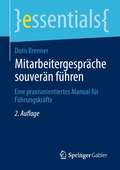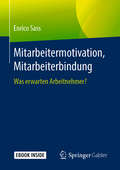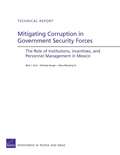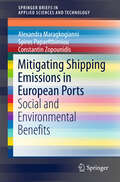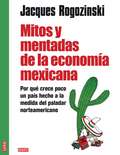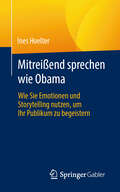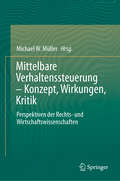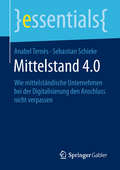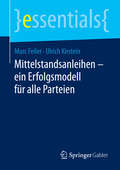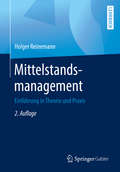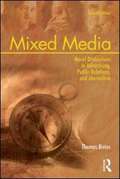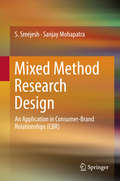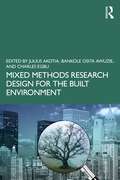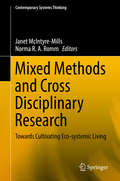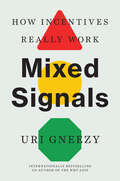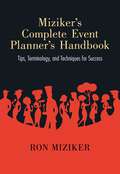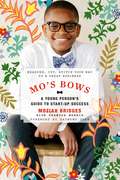- Table View
- List View
Mitarbeitergespräche souverän führen: Eine praxisorientiertes Manual für Führungskräfte (essentials)
by Doris BrennerMitarbeitergespräche stellen ein zentrales Element Ihres Führungsinstrumentariums dar. Indem Sie Ihren Mitarbeitern eine fundierte Rückmeldung zu deren Verhalten und Leistungen in Bezug auf die vereinbarten Ziele geben, schaffen Sie Orientierung und helfen dem Mitarbeiter sich weiterzuentwickeln. Damit das Mitarbeitergespräch keine Einbahnstraße darstellt und für beide Seiten nutzbringend ist, bedarf es einer soliden Vorbereitung, die insbesondere auch konkrete Verhaltensbeispiele aus dem Betrachtungszeitraum als Belege beinhalten sollte. Das richtige Gesprächssetting, eine klare Gesprächsführung sowie ein sicherer Umgang mit Konfliktsituationen sind wesentliche Aspekte, die Ihnen helfen, das enorme Potenzial, das Mitarbeitergespräche beinhalten, auch voll auszuschöpfen. Wie Sie dies schaffen, zeigt dieses essential strukturiert auf und liefert praktische Anregungen sowohl was die Formulierung von Zielen als auch die Vermeidung von klassischen Beurteilungsfehlern betrifft.
Mitarbeitermotivation, Mitarbeiterbindung: Was erwarten Arbeitnehmer?
by Enrico SassDieses Buch gibt Einblicke in die Vorstellungen der jungen Generation von Mitarbeitermotivation und MitarbeiterbindungDieses Buch widmet sich der Mitarbeitermotivation und Mitarbeiterbindung aus Sicht zukünftiger Fach- und Führungskräfte mit einem Hochschulabschluss. Es basiert auf einer Studie, bei der 221 Studenten in den Jahren 2017 und 2018 zu folgenden Punkten befragt wurden:• Ihrer eigenen Person• Ihren Karriereabsichten• Ihren gewünschten Anreizen für eine Arbeitgeberbindung Auf dieser Basis entwickelt Autor Enrico Sass in seinem Buch konkrete Gestaltungsempfehlungen für die Führung und Motivation junger Fach- und Führungskräfte und präsentiert ein Modell für die Mitarbeitermotivation und Mitarbeiterbindung. Entwicklungspfade für Fachspezialisten, mittlere Führungskräfte und Top-ManagerEbenso entwickelt Sass eine Reflexionsgrundlage für die Gestaltung interessanter (motivierender) Aufgabenfelder. Das Buch endet schließlich mit der Präsentation von Entwicklungspfaden für:• Fachspezialisten• Mittlere Führungskräfte • Zukünftige Top-Leitungskräfte (Systemgestalter)Diese Entwicklungspfade können als Grundlage für die Gestaltung einer individuellen Karriereförderung dienen. Ein Buch für Personalverantwortliche sowie erfahrene und zukünftige ManagerDas vorliegende Buch über Mitarbeitermotivation und Mitarbeiterbindung gibt allen eine Hilfestellung, die sich schnell in die Grundlagen der Motivation zukünftiger Fach- und Führungskräfte einarbeiten wollen, nach neuen Ideen für Anreizsysteme suchen oder eine aktuelle Untersuchung für eine weitere konzeptionelle oder wissenschaftliche Arbeit benötigen.Zur Zielgruppe des Werks gehören in erster Linie Menschen mit Personalverantwortung im Bereich Recruiting sowie erfahrene und zukünftige Manager in privaten und öffentlichen Unternehmen, die nach Gestaltungsmöglichkeiten für Rekrutierung und Bindung (zukünftiger) Fach- und Führungskräfte suchen. Interessant ist das Buch außerdem für Startups und Jungunternehmer, die sich in das Thema Mitarbeitermotivation und Mitarbeiterbindung einarbeiten wollen.
Mitigating Climate Change: Proceedings of the Mitigating Climate Change 2021 Symposium and Industry Summit (MCC2021) (Springer Proceedings in Energy)
by David S.-K. Ting Ahmad Vasel-Be-HaghThis book includes the proceedings of the Mitigating Climate Change 2021 Symposium and Industry Summit (MCC2021), which brings together research from experts in academia, industry, and policy arenas to uncover the challenges, sharpen existing solutions, and formulate cutting-edge means to mitigate climate change. It highlights the need to create sustainable measures at all fronts including adaptation, policy, finance, renewable energy, solar, wind, thermoelectric, green transportation, and sustainable healthcare. This symposium will disseminate the state-of-the-art breakthroughs and promote collaborations to maximize opportunities for innovative solutions.
Mitigating Corruption in Government Security Forces: The Role of Institutions, Incentives, and Personnel Management in Mexico
by Nicholas Burger Mary Manqing Fu Beth J. AschMexico has undertaken reforms in recent years to professionalize its police. This report draws on the literature on corruption and personnel incentives and analyzes police reform in Mexico. It addresses the roots of corruption and the tools that could be used to mitigate it and provides an initial assessment of the reforms' effectiveness. The results suggest some progress, though police corruption still remains high and more work is needed.
Mitigating Shipping Emissions in European Ports
by Constantin Zopounidis Alexandra Maragkogianni Spiros PapaefthimiouThe book quantifies the impact of in-port ships' greenhouse gas emissions and air pollution in adjacent cities, and evaluates the feasibility of implementing shore-side electricity facilities in Europe to reduce the unwanted social and environmental effects of ships at berth. The book also discusses the potential of future "green" ports and the use of shore side electricity as a means of achieving them. Individual chapters focus on the economic and social costs of in-port ships' emissions by illustrating current environmental policies to mitigate air emissions and the available abatement measures for in-port emissions. It also discusses the external cost of vessel emissions in ports as well as the impacts on air quality and human health. Examining the expected barriers to the implementation of shore- side electricity facilities, it proposes policies to accelerate the implementation of relevant mitigation measures.
Mitigating Shipping Emissions in European Ports: Social and Environmental Benefits (SpringerBriefs in Applied Sciences and Technology)
by Constantin Zopounidis Alexandra Maragkogianni Spiros PapaefthimiouThe book quantifies the impact of in-port ships’ greenhouse gas emissions and air pollution in adjacent cities, and evaluates the feasibility of implementing shore-side electricity facilities in Europe to reduce the unwanted social and environmental effects of ships at berth. The book also discusses the potential of future “green” ports and the use of shore side electricity as a means of achieving them. Individual chapters focus on the economic and social costs of in-port ships’ emissions by illustrating current environmental policies to mitigate air emissions and the available abatement measures for in-port emissions. It also discusses the external cost of vessel emissions in ports as well as the impacts on air quality and human health. Examining the expected barriers to the implementation of shore- side electricity facilities, it proposes policies to accelerate the implementation of relevant mitigation measures.
Mitos y mentadas de la economía mexicana
by Jacques RogozinskiEn este libro, Jacques Rogozinski establece un sorprendente símil entre la cocina y la economía con el objeto de presentar un análisis riguroso de la situación económica actual de México y de cómo el país podría incentivar su crecimiento si tan sólo se decidiera a hacerlo. Las potencias económicas pretendieron utilizar ?recetas? para garantizar desarrollo y crecimiento económico a largo plazo para los países en vías de desarrollo. Sin embargo, pasaron por alto que los problemas que impiden el crecimiento de las diversas naciones no son idénticos, por lo que la aplicación de una solución estándar resulta poco efectiva. ¿El bajo crecimiento del país es producto de no seguir al pie de la letra las recetas de los grandes gurúes globales? Desde luego que no, y este libro nos explica por qué. México: mitos y mentadas revisa las verdades a medias que se han construido a partir del seguimiento de esos modelos económicos, así como de las problemáticas enraizadas en nuestra sociedad que, sin duda, también impiden su avance.
Mitos y mentadas de la economía mexicana: Por qué crece poco un país hecho a la medida del paladar norteamericano
by Jacques RogozinskiMéxico: mitos y mentadas pone la mesa de las verdades a medias que construyen el discurso del desarrollo y el crecimiento económico del México contemporáneo, un país lleno de excusas, mitos, leyendas urbanas y ficciones ideológicas. En este libro, Jacques Rogozinski establece un sorprendente símil entre la cocina y la economía con el objeto de presentar un análisis riguroso de la situación económica actual de México y de cómo el país podría incentivar su crecimiento si tan sólo se decidiera a hacerlo. Las potencias económicas pretendieron utilizar "recetas" para garantizar desarrollo y crecimiento económico a largo plazo para los países en vías de desarrollo. Sin embargo, pasaron por alto que los problemas que impiden el crecimiento de las diversas naciones no son idénticos, por lo que la aplicación de una solución estándar resulta poco efectiva. ¿El bajo crecimiento del país es producto de no seguir al pie de la letra las recetas de los grandes gurúes globales? Desde luego que no, y este libro nos explica por qué. México: mitos y mentadas revisa las verdades a medias que se han construido a partir del seguimiento de esos modelos económicos, así como de las problemáticas enraizadas en nuestra sociedad que, sin duda, también impiden su avance.
Mitreißend sprechen wie Obama: Wie Sie Emotionen und Storytelling nutzen, um Ihr Publikum zu begeistern
by Inés HoelterDieses Buch zeigt, wie Sie im Beruf authentisch sprechen und Menschen überzeugen – gerade dann, wenn es wirklich drauf ankommt. Inés Hoelter, renommierte Sprechtrainerin und Medienprofi, beschreibt anschaulich, wie durch Sprechduktus und die begleitende Gestik Emotionen erzeugt werden, die ZuhörerInnen mitreißen. Vom klassischen Aufbau einer guten Rede bis hin zur Bedeutung von Storytelling und der Heldenreise lernen Sie die Basics der perfekten Perfomance kennen. Darüber hinaus erläutert die Autorin anhand neurowissenschaftlicher Erkenntnisse, warum bestimmte Taktiken besser wirken als andere und warum manche Reden in den Köpfen der Zuhörer besonders lange nachhallen. Ein Muss für alle, die mit ihrer Performance im Konferenzraum oder auf der Bühne in die nächste Liga aufsteigen wollen.
Mitsubishi Motor Manufacturing of America: The Quest for a Model Workplace
by Lynn Sharp Paine Dale O. CoxeThis case details the sexual harassment case brought against Mitsubishi Motor Manufacturing of America by nearly 300 female employees in April 1996. The recommendations developed for the company by former U.S. Labor Secretary Lynn Marten are presented. In response to the harassment controversy, Marten was asked to review the plant's policies and to formulate a plan for a "model workplace."
Mitsubishi Motor Manufacturing of America: The Quest for a Model Workplace
by Lynn Sharp Paine Dale O. CoxeThis case details the sexual harassment case brought against Mitsubishi Motor Manufacturing of America by nearly 300 female employees in April 1996. The recommendations developed for the company by former U.S. Labor Secretary Lynn Marten are presented. In response to the harassment controversy, Marten was asked to review the plant's policies and to formulate a plan for a "model workplace."
Mittal's Pursuit of Arcelor (A)
by Paul M. Healy Penelope RossanoLakshmi Mittal, CEO of Mittal Steel, a UK-based company with Indian roots, took advantage of a weakened Arcelor that had successfully won a bidding war for Canadian steel company Dofasco, with an unsolicited bid to buy the company. Mittal's plans for acquiring Arcelor were initially thwarted by concerted opposition from Arcelor's board and several European governments. To Mittal's further surprise, on May 26, Arcelor orchestrated a merger with the Russian steelmaker Severstal. Although the proposed merger did not offer Arcelor shareholders as much value as Mittal's deal, Arcelor had structured the deal in such a way that it did not require shareholders' approval. Mittal wondered how he should respond to the Severstal deal. Did it make sense to continue pursuing Arcelor or should he look for other ways to expand his steel empire?
Mittelbare Verhaltenssteuerung – Konzept, Wirkungen, Kritik: Perspektiven der Rechts- und Wirtschaftswissenschaften
by Michael W. MüllerJenseits der imperativen Steuerung durch Ge- und Verbot bedient sich der moderne Staat schon lange verschiedenster Formen einer mittelbaren Einflussnahme auf Wirtschaft und Gesellschaft: er steuert durch die Nutzung seiner Finanz- und Informationsmacht ebenso wie durch die Zuweisung von Risikosphären und Haftungsfolgen. Nach der Rechtsprechung des Bundesverfassungsgerichts darf er dies und genießt bei der Formenwahl regelmäßig große Gestaltungsfreiheit. Neuere Entscheidungen nehmen den Gesetzgeber jedoch verstärkt in die Pflicht, sich der tatsächlichen Wirkungen seiner Steuerungsbemühungen zu vergewissern: Gesetze können das verfassungsrechtliche Untermaßverbot verletzen, wenn Schutzaufträge nicht ausreichend verwirklicht werden. Sie können aber auch gegen das Übermaßverbot verstoßen, wenn sie zu Belastungen führen, denen keine hinreichenden Steuerungswirkungen gegenüberstehen. Durch diese Rechtsprechung erhält die seit langem in Rechts- und Sozialwissenschaften geführte Debatte über die staatlichen Steuerungsmöglichkeiten zunehmende praktische Relevanz: Der Gesetzgeber muss sich des Sachverstandes verschiedener Steuerungswissenschaften bedienen und nach Möglichkeiten suchen, intendierte und tatsächliche Wirkungen seiner Steuerungsbemühungen plausibel zu beschreiben und zu analysieren. Ausgehend von aktuellen Problemstellungen führt der Band Perspektiven der Rechts- und Wirtschaftswissenschaften auf diese Fragen zusammen..
Mittelstand 4.0: Wie Mittelständische Unternehmen Bei Der Digitalisierung Den Anschluss Nicht Verpassen (Essentials)
by Anabel Ternès Sebastian SchiekeAnabel Ternès und Sebastian Schieke erklären in diesem essential anschaulich, was die Vierte Industrielle Revolution kennzeichnet, wieso sich auch der Mittelstand mit Digitalisierung beschäftigen muss und wie eine kritische und erfolgreiche Auseinandersetzung in der Praxis aussehen kann. Die Autoren liefern dazu fundiertes Hintergrundwissen, aktuelle Fallbeispiele, greifbare strategische Hinweise und Konzepte und damit mittelständischen Unternehmen grundlegende Informationen und Tipps zur Digitalisierung.
Mittelstandsanleihen - ein Erfolgsmodell für alle Parteien (essentials)
by Ulrich Kirstein Marc FeilerDie noch relativ junge Finanzierungsform der Mittelstandsanleihe ermöglicht es kleineren und mittleren Unternehmen, sich Fremdkapital über den Kapitalmarkt zu beschaffen und so ihre Finanzierung breiter aufzustellen. Wichtige Parameter einer Mittelstandsanleihe sind das Emissionsvolumen, der Kupon, das Rating und die ,,Bond-Story". Institutionelle wie private Anleger stellen hohe Forderungen an Transparenz und Kommunikation des Emittenten - für noch nicht börsennotierte Unternehmen eine neue Herausforderung.
Mittelstandsmanagement: Einführung in Theorie und Praxis
by Holger ReinemannDieses Buch zum Mittelstandsmanagement liefert in sechs prägnanten Kapiteln kompaktes Wissen für die Führung von mittelständischen Unternehmen. Es beleuchtet die Herausforderungen, mit denen KMU und auch Familienunternehmen in ihren klassischen Lebenszyklus-Phasen konfrontiert sind: die Gründung, das Wachstum, die Reife und die Wende. Fallstudien und Praxisbeispiele ergänzen die theoretischen Abschnitte. Jedes Kapitel bildet eine eigene themenbezogene Lerneinheit. Das Buch dient als Lehrbuch für Studierende mit dem Fokus auf Themen des Mittelstands und ist gleichzeitig sehr zu empfehlen für Geschäftsführer mittelständischer Unternehmen und alle, die eine Unternehmensnachfolge ins Auge fassen.In diesem Buch werden die vier Phasen thematisiert, die KMUs im Laufe der Zeit durchleben. Holger Reinemann begnügt sich jedoch nicht mit der reinen Beschreibung dieser Phasen. Er schürft tiefer, um dem Leser die Unternehmensführung zu erleichtern. Konkret beschäftigt er sich mit den folgenden Themen:Mittelständische Unternehmen: Miniatur-Ausgabe der Konzerne?Gründungsphase: Unternehmen schaffen neue MärkteWachstum: Schwellen der UnternehmensentwicklungDie Reifephase: Bewährung und Bewahrung mittelständischer StrukturenDie Wendephase: Erneuerung oder Niedergang?Auf diese Weise beschreibt das Buch in verständlicher Art alle wichtigen Aspekte der Führung von mittelständischen Unternehmen.
Mixed Media: Moral Distinctions In Advertising, Public Relations, And Journalism
by BivinsMixed Media, Second Edition, introduces readers to the tools necessary for making moral and ethical decisions regarding the use of mass media. The chapters in this text offer insights on: Similarities and differences among the ethical dilemmas faced by the mass media Common ground on which to evaluate media behavior Media obligations Professional ethics Ethical theory and its application to the modern media Considerations of truth and harm New to the second edition is a focus on the three mass media industries most pervasive in today's society: the news media (journalism), advertising, and public relations, with individual chapters giving equal coverage to each. It includes an increased emphasis on "new media" and how ethics affect such concepts as social media, word-of-mouth marketing, and citizen journalism. Readers will come away with a greater appreciation for moral philosophy and theory as a foundation for decision making, and will develop a personal "yardstick" by which to measure their decisions.
Mixed Method Research Design
by Sanjay Mohapatra S. SreejeshThis book is a comprehensive guide to design and conduct the research in management-related field, such as marketing management and human resources management. It provides an overview of the real research conducted by authors throughout their careers and explains the important and growing research design used in management research-mixed method research design. Video tutorials are also included for complete qualitative data collection and data analysis. These videos are included to help readers understand the research and apply the techniques using the recommended software programs. Mixed Method Research Design: An Application in Consumer-Brand Relationships (CBR) begins with an introduction, providing background on the study including related literature in the areas of consumer-brand relationships, which helps the book to show how research questions and research objectives can be developed for the mixed method study. This is followed by a detailed explanation of the methodology, which establishes the ground rule for the study. Finally it takes look at the analysis and results of mixed method research study. Additionally the book examines the procedures of mixing of qualitative and quantitative paradigms in research both in terms of hypothesis development and testing. It helps readers understand how to design their research studies using mixed method design. It also demonstrates managerial implications, to help understand how mixed research design could be used to show contribution to the theory and practice.
Mixed Methods Research Design for the Built Environment
by Bankole Osita Awuzie Charles Egbu Julius AkotiaThe application of mixed methods research design in the built environment discipline by students and academics has continued to grow exponentially. However, with no dedicated mixed methods research design textbook in this domain, students have struggled to conduct research projects involving a mixed methods research design. Mixed Methods Research Design for the Built Environment provides a useful research methodololgy resource for students, academics, and researchers across various disciplines in the built environment such as construction management and project management, property and real estate management, quantity surveying and commercial management, building surveying, building services engineering, civil and geodetic engineering, and other built environment disciplines. The book can also be useful for students and academics outside the built environment knowledge domain. This textbook offers practical and step-by-step guidance on how to apply mixed methods research design, including an elucidation of the various philosophical and methodological underpinnings upon which the choice of a particular variant of the mixed methods research design is predicated. It provides practical case examples and guidance on the processes involved to design and undertake mixed methods research, the advantages and disadvantages of using mixed methods research, and how multiple sources of qualitative and quantitative data can be combined and applied to carry out research projects.
Mixed Methods and Cross Disciplinary Research: Towards Cultivating Eco-systemic Living (Contemporary Systems Thinking)
by Norma R. A. Romm Janet McIntyre-MillsThis book uses mixed methods to extend the concept of “wellbeing stocks” to refer to dynamic ways of working with others. It addresses metaphors and praxis for weaving together strands of experience. The aim of the wellbeing stocks concept is to enable people to re-evaluate economics and to become more aware of the way in which we neglect social and environmental aspects of life. The pursuit of profit at the expense of people and the environment is a central problem for democracy and governance. The vulnerability of cities is a symptom of the lack of balance between individual and collective needs. This book explores the potential for cities, specifically in the regions of Indonesia, Africa, and Australia, to become more productive as sites for food and water security through more creative use of technology. It highlights the need for partners that see food and security feasible at the household level if supports are provided at the community, national and international level. The book examines how these regions are affected by demographics, climate change and people movements, but also explores ways to establish an effective cultural ecosystem management.
Mixed Signals: How Incentives Really Work
by Uri GneezyAn informative and entertaining account of how actions send signals that shape behaviors and how to design better incentives for better results in our life, our work, and our world Incentives send powerful signals that aim to influence behavior. But often there is a conflict between what we say and what we do in response to these incentives. The result: mixed signals. Consider the CEO who urges teamwork but designs incentives for individual success, who invites innovation but punishes failure, who emphasizes quality but pays for quantity. Employing real-world scenarios just like this to illustrate this everyday phenomenon, behavioral economist Uri Gneezy explains why incentives often fail and demonstrates how the right incentives can change behavior by aligning with signals for better results. Drawing on behavioral economics, game theory, psychology, and fieldwork, Gneezy outlines how to be incentive smart, designing rewards that are simple and effective. He highlights how the right combination of economic and psychological incentives can encourage people to drive more fuel-efficient cars, be more innovative at work, and even get to the gym. &“Incentives send a signal,&” Gneezy writes, &“and your objective is to make sure this signal is aligned with your goals.&”
Miziker's Complete Event Planner's Handbook: Tips, Terminology, and Techniques for Success
by Ron MizikerGold Winner for Reference in Foreword Reviews' 2015 INDIEFAB Book of the Year AwardsWith decades of experience as a gala event planner, award-winning director and producer Ron Miziker presents the ultimate guide to planning and executing every special event in this one-of-a-kind guidebook. For professionals and beginners alike, it is designed to be a quick reference for ensuring that any exciting, educational, or entertaining event comes together on time and within budget. The book includes essential information about critical subjects, proven suggestions, and personal anecdotes to make your event memorable and successful. Whether your questions concern layout, techniques, terminology, protocol, quantities, or procedures, this book has the answers with quick-to-understand charts and diagrams that illustrate key information to make the event great—be it a sales meeting, wedding, awards dinner, community festival, concert, fund-raiser, cocktail party, grand opening, political rally, formal dinner, exhibition, press announcement, family celebration, or informal gathering at home.
Mo's Bows: Measure, Cut, Stitch Your Way to a Great Business
by Moziah Bridges Tramica MorrisA Young Person's Guide to Starting Your Own Business Written by a Successful Kidpreneur! Running a successful business can be hard for anyone, but seventeen-year-old Moziah Bridges has becomes a pro at it. His company, Mo's Bow's, is what today's "kidpreneurs" dream of achieving--a successful business selling a product that one loves and is passionate about. Mo shares with young business-minded readers his BOWS of Business: Believe in yourself, take the Opportunity to give back, Work hard/study hard, and have Support from friends and family. He knows there is a Mo's Bows in every household-kids just need someone to help nurture their talents.Aimed at young middle grade readers, Mo's Bows: A Young Person's Guide to Startup Success follows Mo's journey to success and reveals all the ups and downs and important lessons he's learned along the way-as well as provides information and tips on how to start your own business and succeed. Complete with a foreword by New York Times bestselling author Daymond John, this book is sure to inspire budding young entrepreneurs to achieve their business goals.
Mob Girl: A Woman's Life In the Underworld
by Teresa CarpenterThis biography of Arlyne Brickman and her life involved with organized crime. The biography depicts her in every role: girlfriend, operative, and informant.
